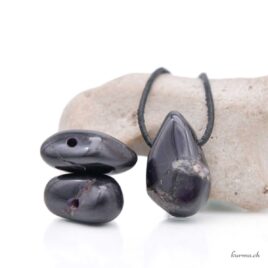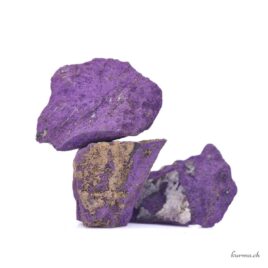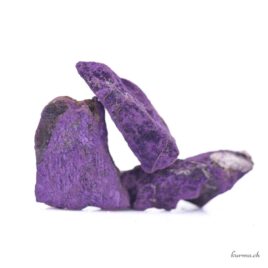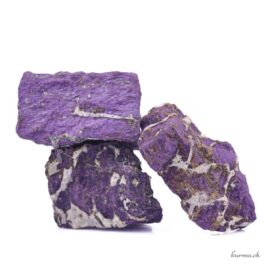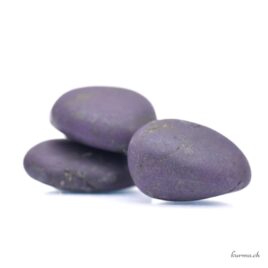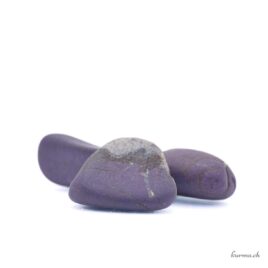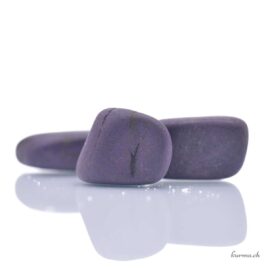Purpurite
gemstones, pendants, rough stones sizes M, L, XL, XXXXL
The presence of manganese explains Purpurite 's violet color - and iron its brown or black hues.
In lithotherapy, the stone is valued for its action on intuition, the clarification of ideas and inner
visions, and possibly on extrasensory faculties.
What are the properties and spiritual virtues of Purpurite in lithotherapy?
The origin of its symbols
Its name, derived from the Latin purpura, reflects its intense violet hues - a color whose symbols are associated with intuition, creativity, the spirit's quest for wisdom and the depths of the unconscious.
Its discovery dates back to 1905. Purpurite is therefore not linked to historical accounts, known ancient myths or proven archaeological traces. Its symbols of spiritual transformation belong to relatively recent esoteric traditions.
The meaning and benefits of Purpurite in lithotherapy
In lithotherapy, Purpurite is a stone of spiritual ascension, helping to open the third eye and the coronal chakra.
Raising levels of consciousness, it nourishes intuition and energies conducive to inner visions, stimulating exploration of your mental capacities.
Its spiritual and purifying energy also promotes a broader vision of your place in the world through its power to clarify thoughts and ideas.
These effects on your spiritual awareness can be an invaluable tool in raising awareness of the importance of your choices and their manifestation. By helping to release emotional blockages, the stone will be useful for clear expression as well as honest and purposeful communication with others.
It will bring an energy of transformation and healing, strengthening self-confidence, especially during periods of change when evolution is not only desirable but necessary.
It is an initiation stone of great Wisdom, which can help free you from your fears and anxieties to accept the facts with greater freedom and serenity, while opening the doors to the invisible worlds.
In meditation
Purpurite is renowned and often used in meditation. Tradition attributes to it powers that can facilitate connection to the subtle planes and with spiritual guides. It works both on opening the upper chakras and on grounding.
On a physical level
There is no scientific proof of Purpurite's action on the physical level, but rather a well-established tradition which attributes to it an aid to blood circulation and wound healing.
Which stones to use with Purpurite?
In lithotherapy, to amplify the virtues of Purpurite, it is advisable to combine it with complementary crystals and stones of high vibratory frequency. For example :
- Association with Cordierite or Iolite will support the path to opening the third eye, as will its combination with Shattuckite or Shattuck stone.
- synergy with Dumortier's Dumortierite or Blue Stone can bring the mental clarity and discipline needed for inner transformation
- Quartz prase or prasin can channel and amplify Purpurite energies in a quest for self and better communication.
Reload and clean
How to purify Purpurite?
Full moon, waveform, fumigation (white sage, palo santo or agarwood), singing bowl, breath/windProlonged exposure to the sun can alter its colors. Likewise, avoid immersing it in water, especially salty water, which could oxidize it or alter its surface. If you still wish to rinse it, do so quickly with distilled water, drying it as quickly as possible with a soft cloth.
Chakras
Third eye (Ajna) chakraCoronal chakra (Sahasrara)
intuition / cosmic consciousness / divine connection
Astrological signs
Aquariusinnovation / vision
Fish
sensitivity / intuition / soothing energy and lucidity
Element
Airthought / communication / mental and spiritual spheres
Purpurite mineralogy
Purpurite is a relatively rare and phosphate, usually formed by the oxidation of triphylite, another lithium phosphate.
It comes in crystallized masses, generally in massive form, with a matt texture and a sometimes rough surface, with an orthohombic crystal system - i.e. mutually perpendicular, as in a cube, but each of the three axes has a different length and the angles between the axes are all 90°, forming an elongated rectangular prism, without cubic symmetry.
It can also be layered with other minerals, and may contain traces of iron, magnesium, calcium or aluminum, which determine its color and texture.
Its characteristic violet to purplish-red color comes mainly from manganese, with iron adding brownish or blackish nuances.
It is found in Brazil, Namibia, France, Western Australia and the United States.
Its hardness on the Mohs scale is 4 to 5.5 - a relatively soft stone.
Lithotherapy
- Zodiac(s) :
- Libra, Cancer, Pisces, Sagittarius, Virgo
- Purification :
- Singing bowl, Fumigation, Moon, Form waves
- Physics :
- Brain, Wound healing, Blood circulation, Neurons (stimulation)
- Emotional :
- Anxiety, Fear
- Spiritual :
- Anchoring, Extrasensory Abilities, Subtle Worlds (connection), Meditation, Cleansing, Spirituality
Mineralogy
- Hardness :
- 4.0-4.5
- Moths scale:
- 4
- Strunz classification :
- Phosphate; Arsenate; Vanadate
- Crystalline system :
- Orthorhombic
- Chemical element :
- Mn, Fe, P, O, Li
- Line color :
- Pink to red
- Density :
- 3.70
- Cleavage :
- Good
- Fracture:
- Uneven, crumbly
- Transparency :
- Opaque, rarely translucent
- Refringence :
- nα = 1.850(2), nβ = 1.860(2), nγ = 1.920(2)
- Birefringence :
- δ = 0.070
- Fluorescence :
- Non-fluorescent
- Colors :
- Dark pink to violet-red
- Magnetism :
- no
- Radioactivity :
- no
*Please note! Some minerals may be toxic and must not be licked or ingested (as such or in the form of powder, elixir or stone water) or be in prolonged contact with the skin or mucous membranes.
*The information on the stones described here are general indications based on our research and experience, and are not exhaustive.
Reproduction in whole or in part of this content is prohibited. More info

